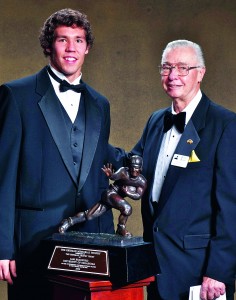
He served as the athletic director of the Downtown Athletic Club (DAC), Lower Manhattan, for 40 years before his retirement in 2005. He was, therefore, the Heisman Executive Director since the annual ceremony was held at the club.
“What made the job so good was that I was in sports my whole life,” said Riska, 74.
Ironically, Riska’s involvement with the Heisman had a touch of fate. He was born across the street from the DAC in 1936. That same year, the man for whom the trophy was named – John W. Heisman – passed away. It was almost as if Riska was destined for his career.
He grew up in the Little Italy section of Manhattan and attended St. Andrew’s parish downtown. He’s been a Bay Ridge resident for the past 46 years and a parishioner at Our Lady of Angels.
Before embarking on his career at the club, Riska played five seasons of professional minor league baseball. The Yankees noticed him in his senior year at Metropolitan H.S. when he threw a no-hitter against George Washington H.S., Washington Heights.
“In 1957, the Yankees invited me to spring training which was a tremendous thrill,” Riska said.
He later played in the Baltimore Orioles system under legendary manager Earl Weaver. However, a bout of chronic bursitis in his elbow ended his playing career. He then took a job as a sporting goods salesman for Rawlings.
His boss notified him of an opening as a part-time athletic trainer at the DAC, and from there, his career blossomed. The club’s board of directors wanted him to change the culture of the club from more of an eating establishment to an athletic facility.
Inspired by an event in which he met St. Louis Cardinals slugger Stan Musial, Riska began creating monthly events in which fans could interact with their favorite sports heroes. He welcomed such athletes as Muhammad Ali, Bob Cousy and Oscar Robertson.
Though he grew up as a New York Giants baseball fan, he even honored the living members of the Brooklyn Dodgers – normally a hated rival.
“They won me over,” said Riska. “I was so impressed with Pee Wee Reese, the gentleman he was.”
During his tenure as the club’s athletic director, Riska transformed the Heisman ceremony. It went from being barely a two-day affair to a full four-day ceremony including a television special and Heisman dinner/dance.
First Experience with the Heisman
Riska said he would never forget his first experience with the Heisman Trophy. He was asked to shadow Ernie Davis, the 1961 winner from Syracuse University. The day’s travels led the two to the Waldorf-Astoria, Midtown, where they had the pleasure of meeting President John F. Kennedy.
Riska ensured that all the details of the ceremony — from the winner’s acceptance speech to his tuxedo rental — were accounted for. He also gave the winner some much-needed advice heading into Heisman weekend.
“We always tried to let him know what he was going to face,” Riska said.
Many of the award winners developed lasting friendships with Riska, who still keeps in contact with Johnny Huarte (Notre Dame, 1964), Steve Spurrier (Florida, 1966), Gary Beban (UCLA, 1967), O.J. Simpson (USC, 1968), Steve Owens (Oklahoma, 1969), Jim Plunkett (Stanford, 1970), Pat Sullivan (Auburn, 1971) and Archie Griffin (Ohio State, 1974-75, the only two-time winner).
“I got there and Rudy put his arm around me and the rest was like a magic carpet ride,” Eddie George, 1995 Heisman winner from Ohio State, told The New York Times. “And that was what Rudy wanted. He wanted every winner to remember his weekend forever.”
Riska was also responsible for running the daily activities of the DAC. He always preached the importance of safety to his 35-person staff and conducted himself in a manner that set a positive example for the club’s members.
“Joe DiMaggio did things effortlessly; he had class,” the late Daily News sportswriter and cartoonist Bill Gallo told The Brooklyn Paper. “It made me think of Rudy Riska. Rudy makes things look easy. He stays in the background and performs effortlessly and beautifully. Rudy Riska is Joe DiMaggio.”
Unfortunately, the DAC was closed due to damage from the terrorist attacks on Sept. 11, 2001. Riska continued in his post until age 69, when he was named Heisman Executive Director Emeritus.
“Do I miss it?” said Riska. “Yeah, I miss it. Not just the Heisman, but I miss the building of the Downtown Athletic Club. It was such a special place with so much history around it.”
As Riska prepares for his 51st Heisman ceremony this winter, he will live on as one of the most influential people in all of college football.
“In the eyes of many, including the former Heisman winners, Rudy is the glue that bonds the Heisman family together,” said current Heisman coordinator Tim Henning.
Follow Jim Mancari on Twitter @JMMancari.
Hi Rudy, hope all is well with you.enjoy reading your History .I have been retired for 10 years. I have Home in Point Pleasant New Jersey which I spend Summers . Love to hear from you. Best to you. Charlie Fautz
Rudy your the greatest, after 36 years I’m loving being married to Francine (Long Island Girl) due to your great insight and influence not to let that gal get away! All the best, from Seattle- Brooks Fenton- It has been our pleasure knowing you. With great Respect, The Fenton’s
Knew RUDY and his brother Steve since we were kids. You have always been an inspiration to me, Gob Bless you”………………